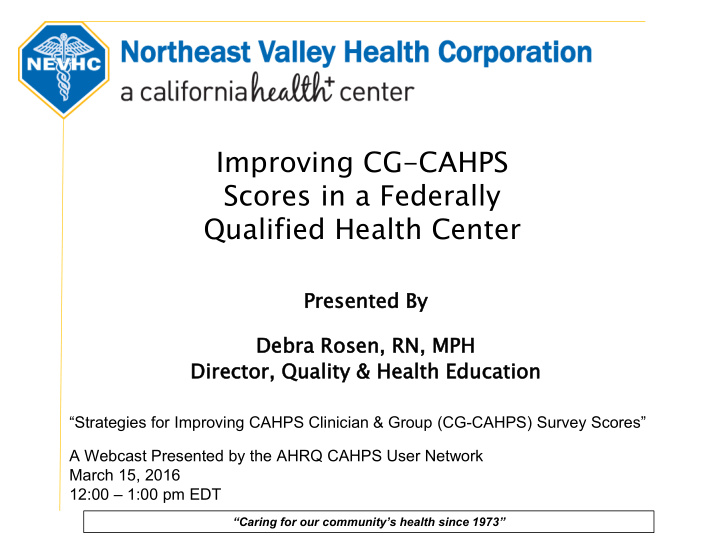



Improving CG-CAHPS Scores in a Federally Qualified Health Center Presen ented B ed By Debra R a Rose sen, R RN, M MPH Director tor, Q Quality & & Health th E Educa cation on “Strategies for Improving CAHPS Clinician & Group (CG-CAHPS) Survey Scores” A Webcast Presented by the AHRQ CAHPS User Network March 15, 2016 12:00 – 1:00 pm EDT “Caring for our community’s health since 1973”
FQHC Los Angeles County 14 sites 65,910 users/patients 291,152 visits in 2014 23% state they are best served in a language other than English 98% below 200% of FPL 81% below 100% of FPL 43.8% adults uninsured 6.8% of children uninsured 24 “Caring for our community’s health since 1973”
Overall and site-specific data are reviewed. ◦ Typical of all of our QI work, we look to sites that are performing well and share best practices Comparison to the benchmark is also made Changes from one year to the next are analyzed to determine if the change is statistically significant. NEVHC also uses other surveys and data to supplement the CAHPS data. ◦ Pulse one-minute survey (Point of Care survey using Natural Language Program) ◦ Patient shadowing ◦ Patient and Family Advisory Councils “Caring for our community’s health since 1973” 25
100.0% 88.7% 88.2% 87.1% 80.0% 72.1% 69.9% 53.1% 60.0% 44.9% 2012 40.0% 88.4% 88.7% 87.6% 70.3% 67.7% 2013 49.9% 44.5% 20.0% 2014 42.8% 48.0% 68.1% 71.8% 86.4% 88.2% 86.5% 0.0% “Caring for our community’s health since 1973” 26
Review the internal data ◦ CG-CAHPS with PCMH Items ◦ Supplemental Data Compliance with regulatory agencies ◦ The Joint Commission ◦ Meaningful Use ◦ BPHC HRSA/Uniform Data System (UDS) Affordable Care Act – Patient Choice Board of Directors “Caring for our community’s health since 1973” 27
Communication Training: Not sufficient. (education is not enough to change behavior) Self-Management Support: Current organization-wide effort Adult Behavioral Health: Successfully implemented annual depression screening for ages 12+ Access to Care: Successful interventions; data improving! “Caring for our community’s health since 1973” 28
Saw provider within 15 minutes of appointment time Response: Always/Usually 100.0% 90.0% 80.0% 70.0% 60.0% 2012 45.5% 50.0% 41.6% 2013 41.0% 41.1% 40.1% 39.3% 40.0% 2014 30.0% 20.0% 10.0% 0.0% Adult Child “Caring for our community’s health since 1973” 29
Access was identified as a priority focus area ◦ Identified through patient experience surveys ◦ Driven by Board of Directors and Executive Team Developed mechanism to measure Share data widely across the organization and review monthly (friendly competition) Allow site specific comparison & interventions Learn best practices (secrets) ◦ Start Medical Assistants 30 minutes earlier ◦ Asked patients to come 15 minutes prior to appt. ◦ Robust calling to assess insurance problems ◦ Team competitions “Caring for our community’s health since 1973” 30
“Caring for our community’s health since 1973” 31
“Caring for our community’s health since 1973” 32
Analyzing variation between sites and as compared to the benchmark helps to determine priority focus areas ◦ Identify areas we excel in ◦ Identify opportunities for improvement Utilize data from CAHPS, but supplement with other patient experience data Determine and prioritize overall and site-specific interventions (compliance with regulatory agencies) Focus priorities at the site or organizational level Significant change/efforts must occur to see CAHPS scores improve. “Caring for our community’s health since 1973” 33
Debra ra Rosen, en, RN, N, MPH Director, Quality and Health Education Northeast Valley Health Corporation (818) 270-9700 ext. 41517 debrarosen@nevhc.org “Caring for our community’s health since 1973” 34
Recommend
More recommend